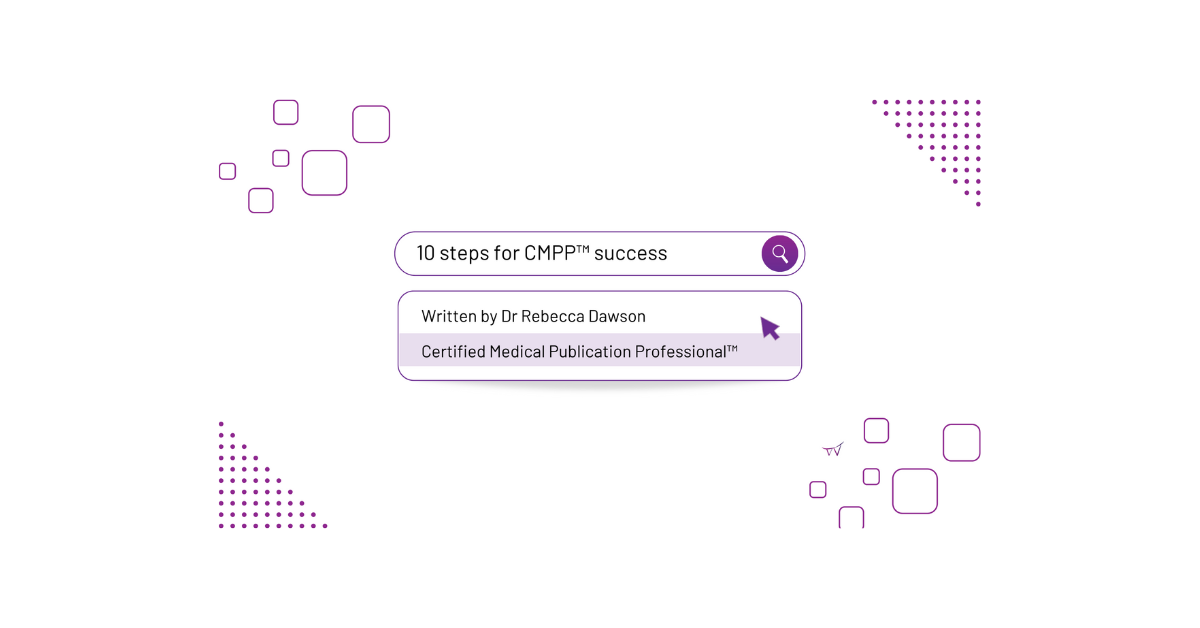The role of medical writers
Medical writers play an important role in translating complex scientific data into a range of materials for healthcare companies, healthcare professionals (HCPs) and patients. Armed with a life science, medical, or veterinary degree, medical writers can shapeshift to any therapy area. They are skilled at understanding and interpreting reams of clinical data to create compelling messages that inform and educate their audiences. Scientific rigour is at the heart of the process. However, whilst maintaining scientific accuracy and integrity in the final material, it’s often easy to lose sight of the bigger picture. Which is:
- To engage key decision–makers, with the aim of improving patient outcomes1
- To educate and support HCPs to make informed decisions by explaining the clinical profile of new and existing therapies, which can help optimise patient outcomes and improve their lived experience
- To inform, engage and connect with patients directly through patient-facing materials by considering what is the most impactful improvement to themselves and their families2
These outcomes aren’t associated with scientific accuracy. Or clinical prowess. They’re all associated with improving outcomes for humans. And so it’s essential in medical communications that we form a genuine human connection. Without this, we may not engage our readers and achieve the objectives above, no matter how compelling the science. Therefore, injecting “humanness” into our writing can turn complex science into meaningful messages that are easy to understand and impact patient outcomes.
In this blog, we will help you catch cold, impersonable writing and give you practical tips for injecting more humanness into your communications
How to spot cold writing
Clinical data is cold. Let’s face it, any time patients and HCPs are seeing P values or Kaplan Meier curves, they’re not thinking with their emotional brain. And if they’re only seeing the data, they might feel like their needs are being overlooked, like they’re just a number.
It’s up to us to find the emotion in the data. That’s our skill. To tease out the story. What would a reduction in seizure frequency mean for a child experiencing multiple seizures a week? Perhaps more time at school, with friends? A return to some kind of normality?
Always ask from your audience’s perspective “Why do I care?”. If you can’t answer this question, your writing might be too cold.
What is the solution?
To truly engage audiences, prioritise language that is accessible, compassionate, and respectful. Incorporating humanness into medical writing may not come naturally, but it’s a skill that can be learned and perfected over time by following some simple tips and tricks.
1. Write conversationally and use person-centric language
It can be easy to overly complicate your messaging by getting too wound up in deep, technical scientific information or medical data. When drafting your copy, avoiding jargon and buzzwords that your audience may not understand can help you deliver clear messaging. Simplify or explain terminology using commonly known scenarios or everyday examples to engage people with your writing.
For example, you may be writing a ‘Top tips’ guide for patients living with inflammatory bowel disease. Separating the tips into sections for people at different stages of life, such as teenagers, students and young professionals, adults, and people over 65 years of age, can help to ensure the advice is as relatable and relevant as possible. You could also split the tips according to different life events, such as starting university, travelling, or starting a family. Immersing the scientific information into phases of life that your audience will be familiar with will allow your writing to sound more conversational and most importantly, encourage them to connect with your key messages!
2. Keep the patient in mind during the planning, writing, and editing stages
Thinking about what’s important for your target audience to know, and what will be of most value to patients, is imperative, particularly during the planning stage of your material. Once the purpose of your writing has been established, you can structure your piece around the key points and messages you want the audience to resonate with and remember. The focus of your material should be on why the clinical trial data, or a new breakthrough in the laboratory, is important for patients – the most vital information your audience needs to know is why this data is significant and how it impacts their life or disease. Remember, always ask from the reader’s perspective: “Why should I care?”
3. Incorporate diversity and inclusion, and consider patients’ values and experiences
Women, the LGBTQIA+ community, people from minority ethnic or lower socioeconomic backgrounds, and individuals who live in rural areas or have low levels of education have historically (and even in the present day) been excluded, or at the very least, underrepresented in science, medicine, and healthcare. Capturing the lived experience of as many different groups of people as possible is a responsibility that all writers should take on, especially if the scope of medical writing projects allows for it. And even if it doesn’t, it’s worth having a conversation about incorporating diversity and inclusion with clients and suggesting ways to making sure the scientific data and the material itself is reflective of people from different walks of life.
Consider reporting clinical data collected from minority ethnic groups (even if the sample size of minority ethnicities in the study is smaller compared to the Caucasian majority). Or why not invite a HCP from a rural community in Ghana to participate in a relevant advisory board. Maybe even consider creating an animation of a trans individual sharing their experience of living with a disease. These steps can help everyone feel seen, heard, and understood.
4. Use AI to support your writing, but don’t rely on it completely
While AI can organise and develop existing ideas, it cannot generate new ones. The current iteration of generative AI models are limited to providing brief, bullet-pointed content suggestions or crafting more interesting and engaging titles. However, only a medical writer can shape the flow of copy, its purpose and intention, adapt the writing style to the target audience, and end ensure the accuracy of the messaging. Therefore, avoid using AI to write whole chunks of text, and remember to check and correctly cite all your sources.
5. Build trust and credibility by making sure your writing is scientifically accurate, engaging, and creative
Despite following all the steps listed above, no amount of humanness or compassion can compensate for inaccurate communications. Transparent and credible information is considered an important attribute by HCPs and patients.4 Therefore, it is imperative that all key messages and data are fully supported by references. To check that empathetic storytelling accompanies the scientific rigour, think about your brand’s target audience and imagine how the writing may connect with them in a meaningful way.
Beyond the science, confirming that the material aligns with the client’s core values and brand messaging is an important step in the quality control process. This alignment ensures consistency with the brand’s previously approved materials, strengthens the brand’s identity, and improves your credibility as a medical writing agency.
Summary: Why should I inject humanness into medical writing?
Injecting humanness into medical writing is undoubtedly of great value to all audiences – stakeholders, HCPs, and most importantly, to patients. The purpose of medical communications is to bridge the gap between scientific research and patient outcomes, and injecting humanness is a key stepping stone in crossing over to the other side. Writing with compassion and empathy is a responsibility that medical writers should take on board right from the planning stage, and a skill that writers should make every effort to develop. Even if this writing style doesn’t come naturally, there are steps you can follow, reflected by the tips provided in this blog, to hone this skill and ensure your work resonates and sparks meaningful change in patient’s lives.
At Word Monster, we don’t just create copy—we are experts in crafting powerhouse content with a unicorn-blend of scientific accuracy and humanity.
Ready to transform your next project with the emotional pull of compelling stories?
Drop us a line to create something extraordinary together.
References
- Concannon TW, et al. Practical guidance for involving stakeholders in health research. J Gen Intern Med. 2019;34(3):458–463.
- Amin D, Vandenbroucke P. Advancing patient-centricity in Medical Affairs: A survey of patients and patient organizations. Drug Discov Today. 28(7):103604.
- Salvagno M, et al. Can artificial intelligence help for scientific writing? Crit Care. 2023;27:75.
- Boston Consulting Group. What Do Patients Want, and Is Pharma Delivering? Available at: https://www.bcg.com/publications/2020/what-patients-want-is-pharma-delivering. Accessed: January 2024.
Further resources
Darshan Talks. Patient-Centric Medical Writing Podcast. Available at: https://darshantalks.com/patient-centric-medical-writing/. Accessed: January 2024.



